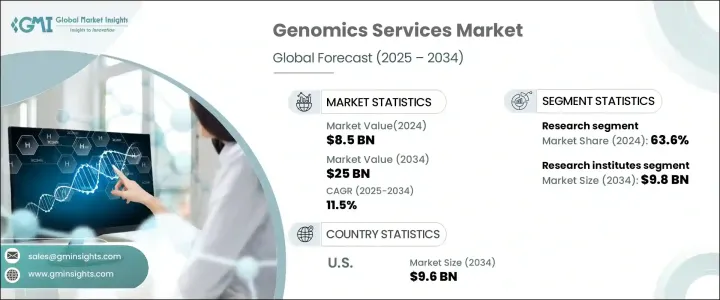
세계 유전체학 서비스 시장은 2024년 85억 달러로 평가되었으며, 2025년부터 2034년까지 연평균 복합 성장률(CAGR) 11.5%로 성장할 것으로 예측됩니다.
유전 질환의 유병률 증가와 맞춤형 의료의 중시가 높아짐에 따라 시장이 확대되고 있습니다. 유전학에 대한 이해가 깊어짐에 따라, 특히 치료 프로토콜에 정밀의료를 통합하는 움직임이 활발해지고, 유전체학 서비스에 대한 수요가 급증하고 있습니다. 세계의 건강 관리 상황은 유전자 검사와 유전자 시퀀싱 기술의 발전으로 보다 개별화된 접근법으로의 변화를 목격하고 있습니다. 이러한 개발은 조기 진단, 표적 치료 및 환자 결과 개선에 대한 길을 열고 있습니다. 세계 정부와 민간 단체가 유전체 연구에 많은 투자를 하고 있으며, 진단 정밀도 향상과 새로운 치료법 개발에 점점 더 많은 노력을 기울이고 있습니다. 정밀의료가 보급됨에 따라 유전체학 서비스는 연구, 임상 진단, 치료 개발에 필수적이 되고 있으며, 시장은 향후 10년간 크게 성장할 전망입니다.

차세대 시퀀싱(NGS)을 포함한 최첨단 기술의 개발은 유전체학 서비스 시장을 전진시키는 중요한 촉진요인입니다. 바이오테크놀러지 신흥기업과 기존 업계 선두는 이러한 기술을 개선하고 그 능력을 높이기 위한 연구개발에 적극적으로 투자하고 있습니다. 시퀀싱 비용은 NGS 채택을 더욱 가속화하고 연구자와 임상의는 DNA와 RNA 시퀀싱을 빠르고 정확하게 수행할 수 있게 되었습니다. 이 기술은 유전자의 돌연변이와 돌연변이를 전통적인 방법과 비교하여 약간의 시간에 확인할 수 있기 때문에 연구 및 임상 진단 모두에서 선호되는 선택입니다. 2023년에는 차세대 시퀀싱 분야에서만 27억 달러의 매출이 있어 유전체 연구와 맞춤형 의료를 추진하는데 있어서 매우 중요한 역할을 담당하고 있는 것으로 밝혀졌습니다. 게다가, 다른 유명한 서비스 유형은 Genotypeping, Microarray, Sanger Sequence 등을 포함하며, 각각 다른 연구 및 임상 요구에 맞는 전문 솔루션을 제공함으로써 시장 성장에 기여하고 있습니다.
| 시장 범위 | |
|---|---|
| 시작 연도 | 2024년 |
| 예측 연도 | 2025-2034년 |
| 시작 금액 | 85억 달러 |
| 예측 금액 | 250억 달러 |
| CAGR | 11.5% |
유전체학 서비스 시장은 조사와 진단으로 나뉘며, 2024년 시장 점유율은 조사 분야가 63.6%를 차지합니다. 활용하여 유전자의 구조, 기능, 돌연변이를 연구하여 신규 치료법의 발견과 유전성 질환에 대한 이해 향상을 촉진하고 있습니다.
미국의 유전체학 서비스 시장도 견조한 성장이 예상되며, 2034년까지 연평균 복합 성장률(CAGR)은 11.5%를 유지하고 있습니다. 인프라와 관민의 강력한 협력 체제로 유전체학 서비스의 급속한 진전에 공헌하고, 계속해서 세계의 유전체학 정세를 리드하고 있습니다.
The Global Genomics Services Market, valued at USD 8.5 billion in 2024, is projected to grow at a CAGR of 11.5% from 2025 to 2034. The market is expanding due to the increasing prevalence of genetic disorders and the rising emphasis on personalized medicine. As the understanding of genetics deepens, the demand for genomic services is surging, particularly with the growing integration of precision medicine in treatment protocols. The global healthcare landscape is witnessing a shift toward more personalized approaches driven by advancements in genetic testing and gene sequencing technologies. These developments are paving the way for early diagnosis, targeted treatments, and improved patient outcomes. Governments and private organizations worldwide are investing heavily in genomic research, with an increasing focus on enhancing diagnostic accuracy and developing new therapies. As precision medicine gains traction, genomic services are becoming indispensable in research, clinical diagnostics, and therapeutic development, positioning the market for significant growth over the next decade.

The development of cutting-edge technologies, including next-generation sequencing (NGS), is a critical driver propelling the genomics services market forward. Biotechnology startups and established industry leaders are actively investing in research and development to refine these technologies and enhance their capabilities. The declining cost of sequencing has further accelerated the adoption of NGS, allowing researchers and clinicians to sequence DNA and RNA quickly and accurately. This technology can identify gene mutations or variations in a fraction of the time compared to traditional methods, making it a preferred choice in both research and clinical diagnostics. In 2023, the next-generation sequencing segment alone generated USD 2.7 billion, underscoring its pivotal role in advancing genomic research and personalized medicine. Additionally, other prominent service types include genotyping, microarrays, and Sanger sequencing, each contributing to the market's growth by offering specialized solutions tailored to different research and clinical needs.
| Market Scope | |
|---|---|
| Start Year | 2024 |
| Forecast Year | 2025-2034 |
| Start Value | $8.5 Billion |
| Forecast Value | $25 Billion |
| CAGR | 11.5% |
The genomics services market is divided between research and diagnostics, with the research segment accounting for 63.6% of the market share in 2024. The increasing investments from both government and private sectors in genomic research are driving the growth of this segment. Academic institutions and biotechnology companies are leveraging genomic services to study gene structure, function, and variation, facilitating the discovery of novel therapies and improving the understanding of genetic disorders. The rapid adoption of genomics in drug discovery and clinical research highlights the growing importance of genomic services in transforming modern healthcare.
The U.S. Genomics Services Market is also expected to witness robust growth, maintaining a CAGR of 11.5% through 2034. This growth is fueled by substantial government funding for genomic research, the availability of advanced research facilities, and increasing public awareness of precision medicine. The United States continues to lead the global genomics landscape, with its well-established infrastructure and strong collaborations between public and private entities contributing to the rapid advancement of genomic services. The growing emphasis on genomic research and the integration of precision medicine into clinical workflows reinforce the significance of genomics in healthcare and drug development, positioning the market for sustained growth in the coming years.